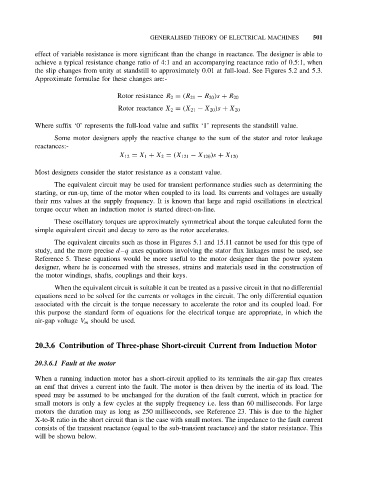Page 511 - Handbook of Electrical Engineering
P. 511
GENERALISED THEORY OF ELECTRICAL MACHINES 501
effect of variable resistance is more significant than the change in reactance. The designer is able to
achieve a typical resistance change ratio of 4:1 and an accompanying reactance ratio of 0.5:1, when
the slip changes from unity at standstill to approximately 0.01 at full-load. See Figures 5.2 and 5.3.
Approximate formulae for these changes are:-
Rotor resistance R 2 = (R 21 − R 20 )s + R 20
Rotor reactance X 2 = (X 21 − X 20 )s + X 20
Where suffix ‘0’ represents the full-load value and suffix ‘1’ represents the standstill value.
Some motor designers apply the reactive change to the sum of the stator and rotor leakage
reactances:-
X 12 = X 1 + X 2 = (X 121 − X 120 )s + X 120
Most designers consider the stator resistance as a constant value.
The equivalent circuit may be used for transient performance studies such as determining the
starting, or run-up, time of the motor when coupled to its load. Its currents and voltages are usually
their rms values at the supply frequency. It is known that large and rapid oscillations in electrical
torque occur when an induction motor is started direct-on-line.
These oscillatory torques are approximately symmetrical about the torque calculated form the
simple equivalent circuit and decay to zero as the rotor accelerates.
The equivalent circuits such as those in Figures 5.1 and 15.11 cannot be used for this type of
study, and the more precise d –q axes equations involving the stator flux linkages must be used, see
Reference 5. These equations would be more useful to the motor designer than the power system
designer, where he is concerned with the stresses, strains and materials used in the construction of
the motor windings, shafts, couplings and their keys.
When the equivalent circuit is suitable it can be treated as a passive circuit in that no differential
equations need to be solved for the currents or voltages in the circuit. The only differential equation
associated with the circuit is the torque necessary to accelerate the rotor and its coupled load. For
this purpose the standard form of equations for the electrical torque are appropriate, in which the
air-gap voltage V m should be used.
20.3.6 Contribution of Three-phase Short-circuit Current from Induction Motor
20.3.6.1 Fault at the motor
When a running induction motor has a short-circuit applied to its terminals the air-gap flux creates
an emf that drives a current into the fault. The motor is then driven by the inertia of its load. The
speed may be assumed to be unchanged for the duration of the fault current, which in practice for
small motors is only a few cycles at the supply frequency i.e. less than 60 milliseconds. For large
motors the duration may as long as 250 milliseconds, see Reference 23. This is due to the higher
X-to-R ratio in the short circuit than is the case with small motors. The impedance to the fault current
consists of the transient reactance (equal to the sub-transient reactance) and the stator resistance. This
will be shown below.

